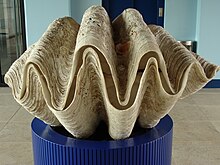
Back Tweekleppiges Afrikaans ذوات الصدفتين Arabic ذوات الصدفتين ARZ Bivalvia AST İkitaylılar Azerbaijani ایکیتایلیلار AZB Ике ҡабырсаҡлы моллюскылар Bashkir Двухстворкавыя Byelorussian Двухстворкавыя BE-X-OLD Миди Bulgarian
| Bivalvia Temporal range: Cambrian – Recent
| |
|---|---|

| |
| Mussels in the intertidal zone in Cornwall, England | |
| Scientific classification | |
| Kingdom: | |
| Phylum: | |
| Class: | Bivalvia Linnaeus, 1758
|


(Tridacna gigas)

The bivalves are a large class of molluscs, also known as pelecypods.
They have a hard calcareous shell made of two parts or 'valves'. The soft parts are inside the shell. The shell is usually bilaterally symmetrical.
There are over 30,000 species of bivalves, including the fossil species. There are about 9,200 living species in 1,260 genera and 106 families. All of them live in the water, most of them in the sea or in brackish water. Some live in fresh water. All are filter feeders: they lost their radula in the course of evolution. A few are carnivorous, eating much larger prey than the tiny microalgae eaten by other bivalves.
The best known examples of bivalves are clams, mussels, scallops and oysters.[1]
- ↑ Ponder W.F. & Lindberg David R. 2008. Phylogeny and evolution of the Mollusca. University of California Press. ISBN 0520-25092-3